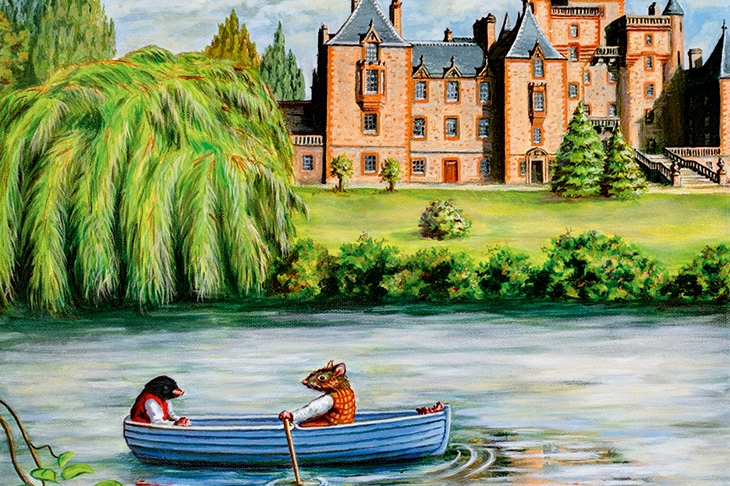The title of Matthew Dennison’s new biography of the man who wrote The Wind in the Willows appears to nod to another children’s classic of the Edwardian period. J.M. Barrie subtitled Peter Pan — first staged in 1904, four years before the publication of Kenneth Grahame’s book — ‘The Boy Who Wouldn’t Grow Up’, and once declared: ‘Nothing that happens after we are 12 matters very much.’
It is Dennison’s contention that for Grahame the clock stopped even earlier. ‘I feel I should never be surprised to meet myself as I was when a little chap of five, suddenly coming round a corner,’ he quotes him writing in 1907:
I can remember everything I felt then, the part of my brain I used from four to about seven can never have altered … After that time I don’t remember anything particularly.
Grahame was effectively orphaned at five when his mother died and he and his three siblings were removed from their alcoholically unreliable father to live with their maternal grandmother at Cookham Dean in Berkshire. While human affection was in short supply there, young Kenneth discovered the beautiful, river-based landscape that would become the setting of his most famous book, and the place to which he would retreat in his imagination when things became difficult in his later life. The stories for adults with which he made his literary reputation also drew upon his memories of this period, featuring the exploits of five parentless children, one of whom is the narrator and clearly stands in for Grahame himself. They were collected in two volumes with titles, The Golden Age (1895) and Dream Days (1899), suggesting a lost world; and Dennison makes extensive and excellent use of the stories in recreating Grahame’s childhood.
Thwarted by his guardians in his ambition to go to Oxford University, Grahame spent 30 years working in the Bank of England, rising to become secretary, one of the institution’s three senior positions. Dennison suggests that although Grahame could have left the bank to live on his literary earnings, he never saw himself as a full-time writer, and was content to stay put, despite having little real interest in his job. He seems to have shown a similar lack of gumption in his personal life, more or less drifting into a disastrous marriage at the age of 40, despite having already settled comfortably into the life of a confirmed bachelor. It is notable that the principal characters in The Wind in the Willows are all happily unmarried, and that the book, as Grahame put it with evident relief, is ‘clean of the clash of sex’.
His dilatory courtship of the fey but determined Elspeth Thomson was largely conducted by letter in an excruciating mixture of baby-talk and mock-Cockney, suggesting another psychological retreat to the nursery. The marriage ‘scarcely outlasted their honeymoon’, Dennison reports, but the couple somehow managed to produce a child, Alastair, who was born completely blind in one eye and partially sighted in the other. Overcompensating for his disability, his parents decided that he was preternaturally gifted, Elspeth declaring him a child of the ‘elfin-celestial sort’, born for some ‘high purpose’.
By frequently telling Alastair how marvellous he was they turned him into a monster of conceit, some of whose worst characteristics Grahame drew upon when creating Mr Toad. ‘A warning to Inferiority,’ Alastair wrote to his mother aged 11, using the nickname he had invented for his father:
If he does not take me to the pantomime, and to Montecarlo, and give me three helpings of Xmas pudding and mince pies and otherwise show paternal affection, well — I’ll let him know it.
He undoubtedly had cause for complaint. Although The Wind in the Willows was supposedly born out of the stories Grahame told him, Alastair was frequently abandoned to the care of others, even during a long convalescence from severe peritonitis when he was just four. He claimed to have had visions of Christ during this illness, and while at Oxford, failing both to pass exams and make friends, he was found decapitated on a railway line, his pockets stuffed with religious tracts. Against all the evidence, his parents allowed themselves to believe that the boy’s death was accidental.
This sorry tale has been told before, and while Dennison does not add a great deal to earlier books by Peter Green (1959) and Alison Prince (1994), he is particularly good on the way Grahame ‘insisted on his own physical and emotional connectedness to the landscape’ and freely admitted that he preferred places to people. It would have been nice to have had The Wind in the Willows placed in the context of other children’s literature of the period, and be given some sense of how Grahame’s exploration and celebration of the countryside chimed with prevailing Edwardian notions of England and Englishness; but by keeping tightly focused on Grahame, Dennison has produced a book that is brief, brisk and very readable.






Comments